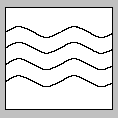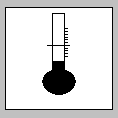| Palm oil | [German version] |
Table of contents |
|
| General: | ||
| Product information | ||
| Packaging | ||
| Transport | ||
| Container transport | ||
| Cargo securing | ||
Product information
Product name
| German | Palmöl, Palmfett |
| English | Palm oil |
| French | Huile de palme |
| Spanish | Aceite de palma |
| Scientific | Elaeis guineensis |
| CN/HS number * | 1511 ff. |
(* EU Combined Nomenclature/Harmonized System)
Product description
„Oils“ is a collective term for more or less viscous, generally organic-chemical liquids. Depending on their chemical composition, a distinction may be drawn between fatty, essential, mineral and silicone oils. Fatty oils include liquid, semisolid and solid products of vegetable and animal origin. They are also known as sweet oils.
Palm oil is a dark yellow to yellow-red oil (high carotene content) of vegetable origin obtained by pressing or boiling the flesh of the fruit of the oil palm (Elaeis guineensis). Palm oil differs from palm kernel oil, the latter being obtained from the kernels of the oil palm.
Quality / Duration of storage
The acid value of an oil may be used as a measure of quality. However, the acid value of the oil must not be too high, as this denotes an excessively high content of free fatty acids, which causes the oil to turn sour. Discoloration may also occur. Palm kernel oil should have an acid value of at most 0.1 – 1.0% [1], or 5% according to [2].
Oils and fats spoil by readily becoming rancid. Rancidity is promoted by light, atmospheric oxygen and moisture and leads to changes in odor and taste. Thus, the tanks and barrels must be filled as full as possible, taking into consideration the coefficient of cubic expansion (see Density), so that as little ullage space as possible is left above the cargo. Do not load rancid oil, since it does not meet quality requirements.
Do not accept for loading palm oil contaminated by ferrous and rust particles or by seawater.
Maximum duration of storage is as follows:
| Temperature | Max. duration of storage | Source |
|---|---|---|
| 30°C | 6 months | [1] |
Intended use
Palm oil is processed to produce edible fats (margarine), soaps and candles and is used in pharmacy and cosmetics and as an important raw material in oleochemistry (fat chemistry).
Countries of origin
This Table shows only a selection of the most important countries of origin and should not be thought of as exhaustive.
| Europe | |
| Africa | East and West Africa |
| Asia | Indonesia, Malaysia, India |
| America | |
| Australia |
Back to beginning
Packaging
This oil is mainly transported in tanks, and only rarely in barrels and jerricans.
Back to beginning
Transport
Symbols
 Liquid cargo |
 General cargo |
 Temperature-controlled |
Means of transport
Ship, truck, railroad
Container transport
Heatable tank containers
Cargo handling
To be able to pump the oil out of the tanks, it must be at the required pumping temperature. This is only possible, however, if the oil has been kept liquid during the voyage (above a minimum temperature). Loading, travel and pumping temperatures must be precisely complied with, since any change in consistency which occurs during transport may prove irreversible.
If the oil solidifies in the tanks, it cannot be liquefied again even by forced heating. In the vicinity of the heating coils, the oil melts, scorches, discolors and becomes rancid.
Pumping out may be difficult in cold weather. The oil may cool too rapidly in the long lines and solid deposits form on the outer walls, which cannot be pumped out and prevent the still liquid cargo from reaching the suction valve. This problem can be solved by appropriate heating or insulation of the lines.
Where the oil is packaged in barrels, the latter have to be handled with appropriate care. Damaged barrels quickly lead to oil leakage and thus to loss of volume or to damage to other parts of the cargo.
Density
| 0.921 – 0.947 cm3 [1] | |
| 0.920 – 0.926 cm3 [2] |
All fats and oils have a particular density (approx. 0.9 g/cm3). With a rise in temperature, however, density diminishes, thereby leading at the same time to an increase in volume. This behavior is described by the coefficient of cubic expansion and is known as thermal dilatation.
The coefficient of cubic expansion amounts to: g = approx. 0.000727°C-1
As a rule of thumb, oils may be expected to increase in volume by 1% of their total volume for each 14°C temperature increase. In particular in the case of oils requiring heating, such as palm oil, the ullage space must be calculated accordingly.
When filling the barrels or tanks, attention must however be paid to the expansion behavior of the cargo in the event of a rise in temperature (risk of bursting of barrels).
Stowage space requirements
Special tank
Segregation
Not applicable to liquid cargoes in tanks
Cargo securing
In the case of liquid cargoes, it is important for the ullage space above the cargo to be as small as possible, so that only slight movement of the cargo is possible. Movement in liquid cargoes may have a negative effect on the stability of the means of transport (e.g. during cornering in the case of trucks and trains or when ships roll and pitch).
Barrels have to be secured in such a way that they cannot slip in the hold or on the loading area and suffer damage.
Back to beginning
Risk factors and loss prevention
RF Temperature
Palm oil requires particular temperature conditions (SC II) (storage climate conditions).
A written heating order must be obtained from the consignor before loading is begun. This order must always be complied with during the entire transport chain.
The solidification temperature is of considerable significance in the transport of fatty oils and fats. They must remain liquid during loading, during the voyage and during unloading. Chill haze (separation) begins if cooling causes the temperature of the oil to approach solidification point, the oil becoming ointment-like and finally solid, such that it is no longer pumpable.
Separation and the associated change in consistency from liquid to solid occurs more readily upon cooling, the higher is the solidification point.
Palm oil has a relatively high solidification point/range of 41 – 31°C. In its native countries it has a liquid consistency, but in temperate latitudes it is fatty and has to be heated. Palm oil is thus also known as palm fat.
The oils must only be heated by a few °C per day, otherwise the risk of rancidity and other negative changes arises.
The following Table merely constitutes a rough estimate of appropriate temperature ranges. Temperatures may deviate from these values, depending on the particular transport conditions.
| Designation | Temperature range | Source |
|---|---|---|
| Loading temperature | 40°C | [1] |
| Favorable travel temperature | 30 – 35°C, not < 25°C | [1] |
| approx. 35°C | [2] | |
| Solidification temperature | 41 – 31°C | [1] |
| approx. 35°C | [2] | |
| Pumping temperature | 49 – 50°C, not > 55°C | [1] |
| approx. 50°C | [2] |
The rate of heating should be no greater than 8°C/day.
The travel temperature must be complied with as far as possible during transport, to minimize oxidation processes.
Towards the end of the voyage, the temperature of the oil must be slowly raised to the appropriate pumping temperature. Unless otherwise recommended by the consignor, the following plan may, for example, be used for heating (gradual heating to prevent singeing, which causes the color to darken and value to be lost due to rancidity) [1]:
| 1st day heat to 26.5°C, not < 26°C | |
| 2nd day heat to 29.5°C | |
| 3rd day heat to 38°C | |
| 4th day heat to 46°C | |
| 5th day heat to 49 – 50°C and keep at 50°C without fail to port of discharge. The temperature must never be higher than 55°C, since palm oil rapidly becomes rancid. Tank wall heating must be reduced on unloading. |
Too great or rapid an increase in temperature entails considerable losses in quality.
Back to beginning
RF Humidity/Moisture
Fats and fatty oils are insoluble in water. However, contact with water may give rise to soluble lower fatty acids and glycerol, which cause rancidity together with changes in color (yellow to brown), odor and taste as well as gelling and thickening. For this reason, the tanks must be absolutely dry after cleaning.
Back to beginning
RF Ventilation
Ventilation must not be carried out under any circumstances, as it would supply fresh oxygen to the cargo, which would promote oxidation processes and premature rancidity. In this connection, care should be taken to ensure that the tank is filled as full as possible, taking into consideration possible thermal dilatation, and immediately closed. Palm oil bleaches on contact with air [1].
Back to beginning
RF Biotic activity
Palm oil displays 3rd order biotic activity.
It belongs to the class of goods in which respiration processes are suspended, but in which biochemical, microbial and other decomposition processes still proceed.
Care of the cargo during the voyage must be aimed at keeping decomposition processes to a low level.
Back to beginning
RF Gases
Before anybody enters an empty tank, it must be ventilated and a gas measurement carried out. Oxidation processes may lead to a life-threatening shortage of O2.
Back to beginning
RF Self-heating / Spontaneous combustion
The oil may ignite spontaneously in conjunction with sawdust or material residues.
Back to beginning
RF Odor
| Active behavior | Palm oil has an unpleasant, sweetish (violet-like) odor and a neutral taste. |
| Passive behavior | Tanks and barrels must always be odor-free, since there is a risk that quality will be diminished in particular where the previous cargo had a strong odor. |
Back to beginning
RF Contamination
| Active behavior | Leaking oil leads to massive contamination and may make whole cargoes unusable. Of considerable significance with regard to tank cleaning is the iodine value, which is a measure of how strong a tendency the oil has to oxidation and thus to drying. Drying is particularly detrimental to tank cleaning, as the oil/fat sticks to the walls and can be removed only with difficulty. On the basis of drying capacity, oils are divided into nondrying, semidrying and drying oils. With an iodine value of 43 – 58, palm oil is a nondrying oil, which means that it does not dry significantly on contact with atmospheric oxygen and the tanks are easily cleaned. |
| Passive behavior | Palm oil is sensitive to contamination by ferrous and rust particles and water (especially seawater). The tanks or barrels must be thoroughly cleaned (rinse out with fresh water) and hygienic before filling. |
Back to beginning
RF Mechanical influences
In the case of transport in barrels, extreme mechanical stresses, such as dropping, tipping over or bumping, may lead to breakage of the barrels and thus to leakage.
Back to beginning
RF Toxicity / Hazards to health
Before anybody enters a tank, it must be ventilated and a gas measurement carried out. Oxidation processes may lead to a life-threatening shortage of O2.
Back to beginning
RF Shrinkage/Shortage
Where this oil is packaged in barrels, weight loss from leakage is always to be expected.
Losses due to adhesion of the cargo to the tank walls are minimal (< 0.3%), because palm oil is a nondrying oil.
Back to beginning
RF Insect infestation / Diseases
No risk.
Back to beginning
